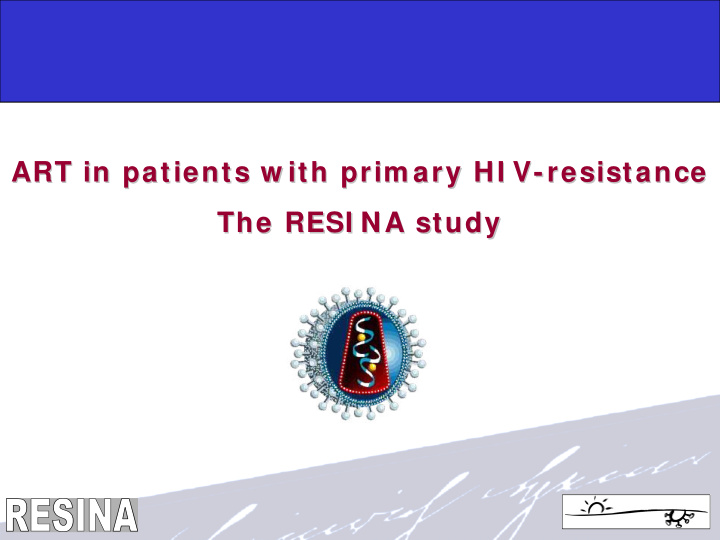



ART in patients w ith prim ary prim ary HI V HI V- - resistance resistance ART in patients w ith The RESI NA study The RESI NA study
The RESINA Study The RESINA Study (Genotypic HIV HIV- - Resistance Resistance in Treatment in Treatment - - Naives) Naives) (Genotypic • Ongoing prospective study in Nordrhein-Westfalen • Inclusion: Untreated HIV-infected subjects before HAART initiation • Study period: 2001-2009, 1936 patients until 2008 • Aims of study: – Epidemiology of primary resistance in chronically HIV-infected patients – Evaluation of efficacy of HAART guided by resistance testing – Bioinformatic analysis of resistance data • Coordinating centers: University of Cologne MPI in Saarbrücken University of Düsseldorf
Prevalence of drug resistance Prevalence of drug resistance in ART- -na naï ïve persons ve persons in ART Germany 9 Germany 9 2001–5 2001–5 USA 2 USA 2 USA 4 London 8 USA 4 London 8 9% 9% 1999–2003 1999–2003 2004–5 2000–4 2004–5 2000–4 16% 16% 10% 7% 10% 7% Switzerland 1 Switzerland 1 1996–2005 1996–2005 8% 8% France France Los Angeles 7 Los Angeles 7 Chicago 7 Chicago 7 2006-7 2006-7 2003–5 2003–5 2003–5 2003–5 10% 10% Europe 6 Europe 6 20% 20% 25% 25% 2002–3 2002–3 9-14% 9-14% San Francisco 3 San Francisco 3 2004 2004 STD STD 9% 9% Burkina Faso 10 Burkina Faso 10 PHI PHI 4.8% 4.8% 10% 10% USA/Australia 5 USA/Australia 5 2000–6 2000–6 13% 13% 1. Yerly et al. XV International Drug Resistance Workshop; June 13-17, 2006; Sitges, Spain. Abstract 105; 2. Eshleman et al. XV International Drug Resistance Workshop; June 13-17, 2006; Sitges, Spain. Abstract 109; 3. Truong et al.; XV International Drug Resistance Workshop; June 13-17, 2006; Sitges, Spain. Abstract 102; 4. Ross, et al. XV International Drug Resistance Workshop; June 13-17, 2006; Sitges, Spain. Abstract 107; 5. Little S, et al. XV International Drug Resistance Workshop; June 13-17, 2006; Sitges, Spain. Abstract 97; 6. Wensing et al. XV International Drug Resistance Workshop; June 13-17, 2006; Sitges, Spain. Abstract 98; 7. Bennett, et al. XV International Drug Resistance Workshop; June 13-17, 2006; Sitges, Spain. Abstract 103; 8. Garcia A, et al. HIV Med 2006;7:1; 9. Oette et al. HIV 8, Glasgow 2006, P236; 10. Tebit et al. J AIDS 2006:43:144;
Descamps-D CROI 2009 RESINA FRANCE RESINA FRANCE Altogether 9.5 % 10.6 % NRTI 6.4 % 5.8 % NNRTI 3.0 % 2.8 % PI 2.0 % 4.7 % Males vs. females p=0.04 NS Subtype B vs. others p=0.002 NS CD4 / VL NS NS Age NS NS transmission group NS NS Ethnicity NS NS disease stage NS NS
Prevalence of of primary primary resistance resistance Prevalence Prävalenz der HIV ‐ 1 Primärresistenz % übertragene Resistenz 20 15 10 5 0 2001 2002 2003 2004 2005 2006 2007 2008 Prävalenz
Prevalence of of primary primary resistance resistance Prevalence England, Chilton Chilton et al. 2008 et al. 2008 England,
Treatment cohort cohort (n= 677) (n= 677) Treatment • Prospective follow-up of first-line ART – Wild type virus vs. resistant virus • Association with treatment success: – Homosexual transmission (76 vs. 67 %; p=0,01) • No associaton with treatment success: Age, gender, time since HIV-diagnosis, CD4-cell and viral load at baseline, ethnic origin, nationality, other transmission routes, resistance within substance groups NRTI, NNRTI, PI, and revertants, HIV subtype • Similar results for OT- and ITT-analysis (48 wks, vl < 50 c/mL)
Screening for for HBV HBV Screening Patients analysed for HBsAg, anti-HBs and antiHBc n=767 HBsAg n=32 (4,2%) anti-HBs n=214 (27,9%) anti-HBc n=331 (43,2%) HBV-DNA n=271 HBV-DNA pos. n=18 (6,6%) HBV-DNA, HBsAg+ n=7 HBV-DNA, HBsAg – n=11
Changes in in mutational mutational profile profile Changes before treatment treatment before 54 untreated patients with 2 resistance analyses n = 17 n = 37 Resistance mutations No resistance mutations n = 9 n = 8 <180 days >180 days No alterations 6 x increasing number of mutations 2 x decreasing number of mutations ⇒ superinfection ? ⇒ selection pressure ?
The Future The Future • Continued surveillance of resistance in NRW • Subgroup analyses (risk factors, treatment responses) • Representative primary resistance data for Germany by cooperative network • Development of prediction tool for treatment naive patients • Clinical validation of newly developed prediction tools
your attention attention Prä-Expositions-Prophylaxe for your PrEP you for Thank you Thank
Recommend
More recommend